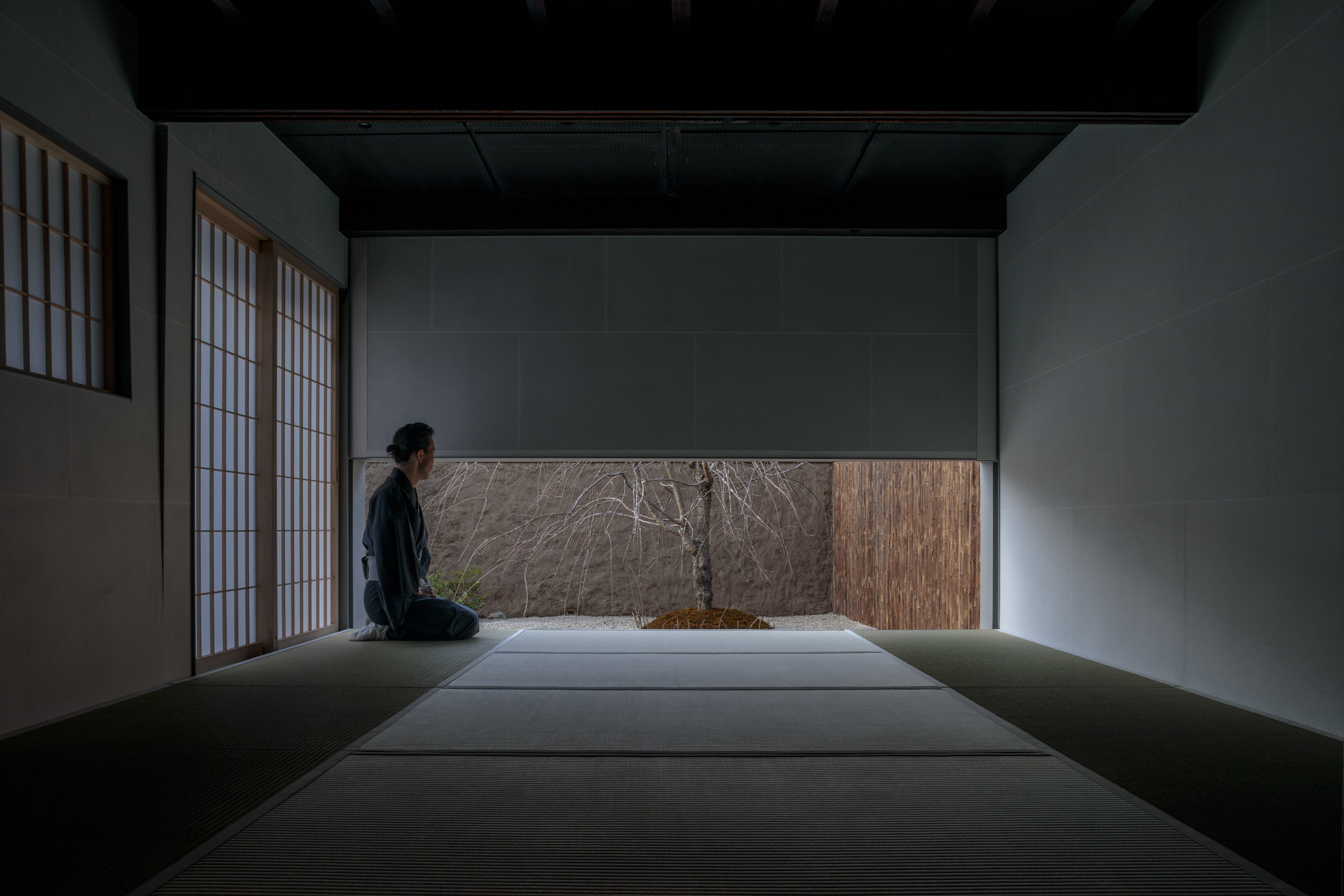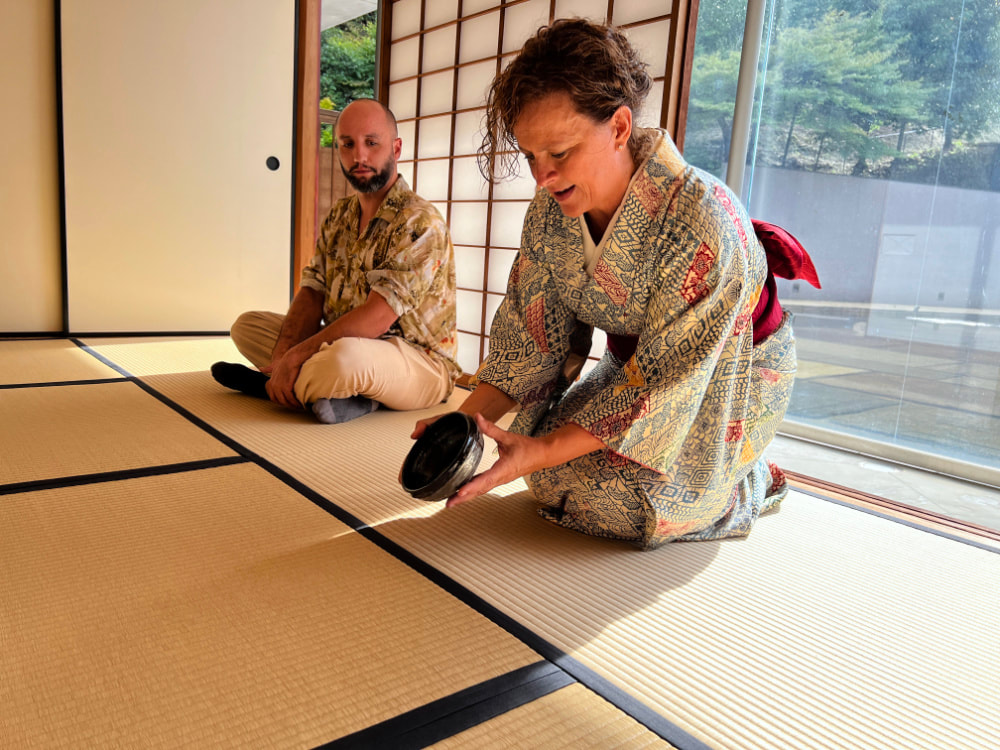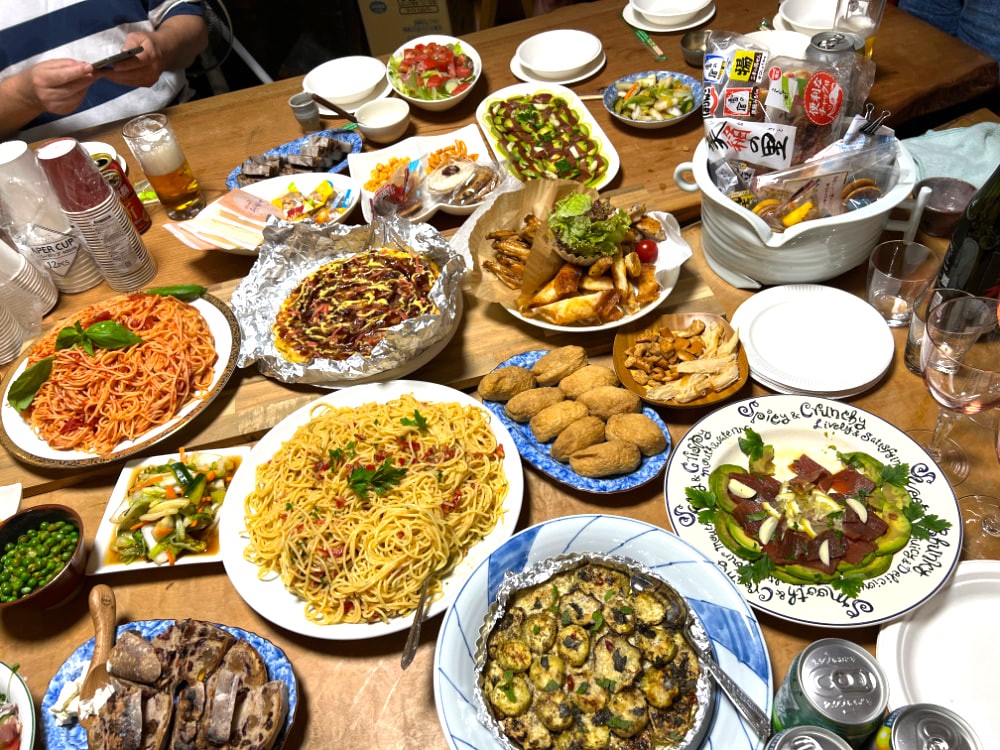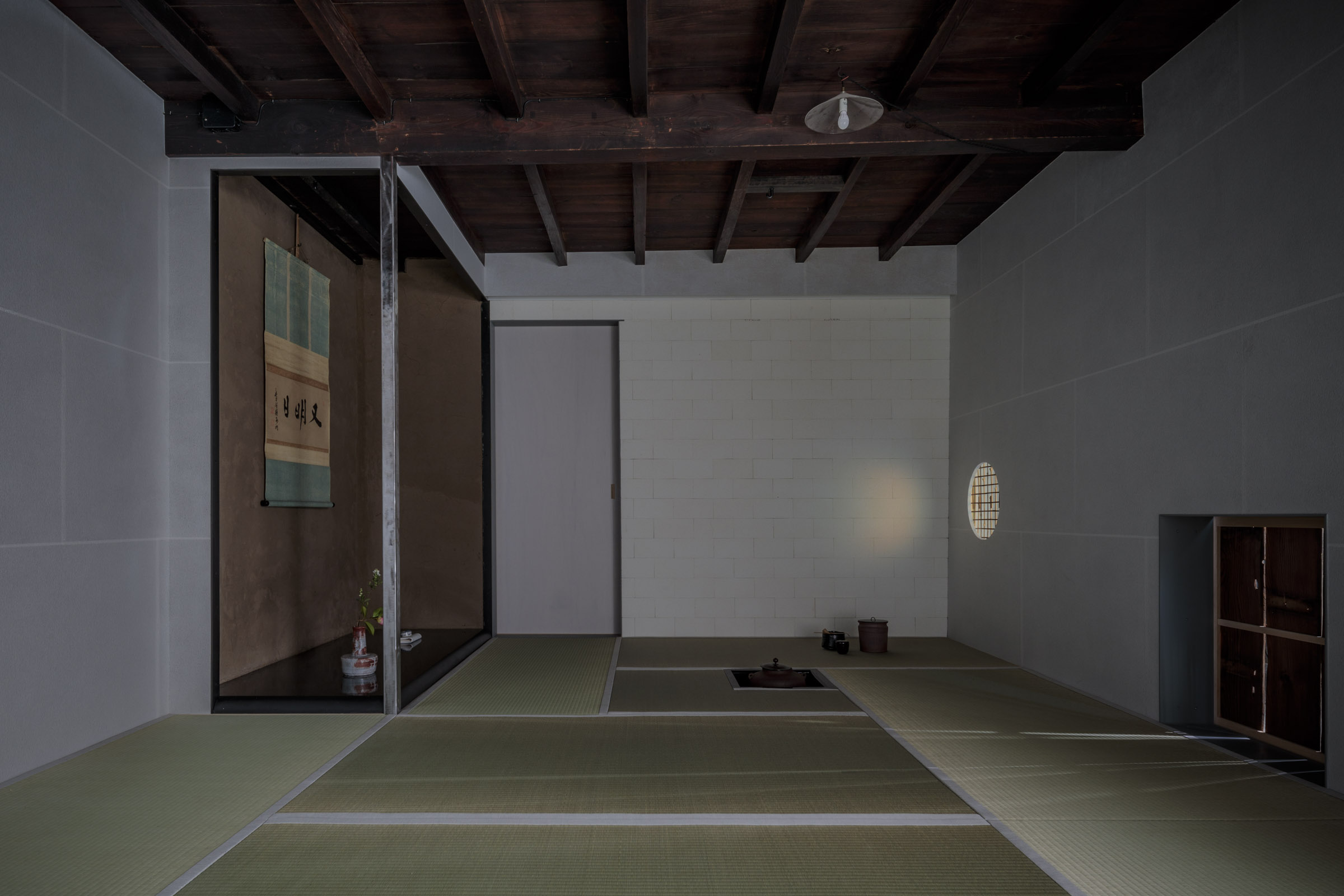焼き物の町 多治見で茶道のあれこれ ~焼き物・人・茶室~ 前編
たじみDMO(一般社団法人 多治見市観光協会)では、合同会社Mimir(小名田町1-3-4)に委託し、多治見を紹介するコラム(Discover TAJIMI 英語版・日本語版)を執筆していただいています。今年度は2つのテーマで配信される予定ですが、1つ目のテーマ「茶道」についてのコラム前編が完成したのでご紹介します。

今回は日出ずる国・日本で、何世紀にも渡って磨かれてきた素晴らしい伝統文化である茶道についてのお話をしましょう。茶道もしくは茶の湯とも呼ばれ、抹茶を点てて飲むのですが、特別な空間、道具を伴い、そのお作法も細かい手順に則って進める荘厳な儀式なのです。
この茶道の儀式は日本人の日常生活の中にある美を見出し、大事にするという禅の教えがルーツとなっています。結局のところそれは客をもてなす方法なのですが、まるで社交ダンスの振付のようにすべてが決められた順序に従って行われ、その中にも美を感じさせるのです。茶道の起源は中国まで遡り(※1)、日本では鎌倉時代に禅僧たちによって初めて行われました(※2)。禅僧たちは長い座禅を眠らず乗り切るために、ちょっとした気分転換が必要だったかもれしませんね。時を経ていきながらも茶道は進化して現在に至るわけですが、16世紀の僧侶であり茶人でもあった千利休は茶道全体を洗練させ、人との出会いを大事にするという感覚を与えたのです。
Ah, my dear friend, let me regale you with a tale of the Japanese tea ceremony, a delightful cultural tradition that has been practised for centuries in the Land of the Rising Sun. You see, this ceremony, also known as Chanoyu, Chado, or Sado, is a rather splendid way of preparing and drinking green tea, involving very particular places, procedures, and equipment.
Now, this tea ceremony has its roots in the principles of Zen Buddhism, and it’s all about the reverence of beauty in our daily lives. It’s a rather aesthetic way of welcoming guests, where everything is done according to an established order, much like a well-choreographed dance. The origins of this ritual can be traced back to China, and it was first practised in Japan during the Kamakura period by Zen monks who apparently needed a little pick-me-up to stay awake during those long meditation sessions. Over time, the tea ceremony evolved, thanks in part to the 16th-century monk and tea master Sen no Rikyu, who added a touch of refinement and intimacy to the whole affair.

日本の茶道では全員が床に座り、儀式の主役の一つである茶碗を全員でシェアして使います。これは茶葉を使って淹れる中国茶のようにお茶そのものを楽しみ、味わうことにフォーカスした方法とは全く異なります。戦国時代の武将たちは茶道や茶道具を好み、そして茶室はその長い戦国時代の間、重要人物と会談する場所でもありました。
今日では茶道は趣味の一つとして多くの人に楽しまれ、観光客が体験できる茶室もあります。茶道は和を重んじ、人への尊敬の念、清廉潔白さそして静謐さを兼ね備えた日本文化の真髄と言えます。今回の記事では多治見でカジュアルに茶道を楽しんでいるグループを2件紹介します。
この記事を読んでいる皆さん、本題に入る前に一言。お抹茶をちびりちびりと飲みながら複雑な手順に翻弄されていても、茶道で最も大切なことはその瞬間なんだということをどうか忘れないでください。結局のところ日本の「一期一会」という言葉にあるように、出会いも空気感もその一瞬、その場所にしかなのですから。
In the Japanese tea ceremony, everyone sits on the floor, and all the guests share a single tea bowl, which is like the star of the ritual. This is quite different from the Chinese style tea ceremony, where loose-leaf tea is used, and the focus is more on the enjoyment and taste of the tea itself. The mightiest warlords in mediaeval Japan loved the tea ceremony and the tea bowls, and the tea room was a place where they could meet important people during the long civil war in Japan.
Nowadays, the tea ceremony is enjoyed by many as a hobby, and there are even places where tourists can experience it for themselves. It’s become a quintessential part of Japanese culture, representing harmony, respect, purity, and tranquilly. This time we will introduce two places in Tajimi where you can enjoy the ceremony in an unpretentious and fun way, as well as the space where the ceremony is performed
So, my dear, as you sip your tea and ponder the intricacies of this ancient tradition, remember to cherish the moment and the connections it fosters. After all, as the Japanese idiom “ichi go ichi e” reminds us, each encounter is a once-in-a-lifetime experience.
長期作陶滞在施設HO-CAのお茶会
HO-CA’S OCHA-KAI

趣深い多治見の町に位置する長期作陶滞在施設Ho-caは世界を旅する陶芸愛好家たちのホットスポットとなっています。ここに訪れるアート冒険家の多くは抹茶茶碗の制作に魅力を感じているのですが、それが主役の一つである茶道についてはあまり知らないようです。茶碗は単なる器ではなく、茶道の芸術に深く結びついたシンボルなのです。ですから抹茶碗作りを志している方たちには茶の湯の真髄を理解するため、茶道に没頭することを心からお勧めします。
しかしながら、茶道はその文化の濃さと複雑さで、素人には敷居が高く感じられるかもしれません。そこで長期作陶滞在施設Ho-caでは熱心な生徒たちのため、気楽なお茶会を開いています。この楽しい会では茶道の入門として親しみやすく紹介しており、その意義を理解することで陶芸への造詣がより深まることでしょう。
In the quaint town of Tajimi, the Ho-Ca studio has become quite the hotspot for globe-trotting pottery enthusiasts. These artistic adventurers often find themselves drawn to the creation of chawan, or tea bowls, despite their often limited knowledge of the tea ceremony where these delightful vessels take centre stage. You see, the chawan is not merely a bowl but a symbol deeply intertwined with the art of Sado. So, dear aspiring chawan creator, we humbly suggest that you immerse yourself in a tea ceremony to truly grasp the essence of your craft.
However, be warned! Sado, the way of tea, is a rich and complex culture that may prove elusive to the uninitiated. Fear not, for Ho-Ca has devised a solution: a less formal tea party for its eager students. This delightful gathering offers a more approachable introduction to the world of chawan and its significance, ensuring that your pottery pursuits are steeped in understanding.

僕が尊敬するHo-caを率いる柴田節郎先生のお話をさせてください。多治見市内でも絵になる風景に囲まれた場所に岐阜県現代陶芸美術館を備えたセラミックパークMINOがあり、その施設内に素敵なお茶室があります。ここでは陶芸講師である柴田先生と茶道を学んでいる方々がお茶会を手伝い、美味しいお抹茶と和菓子に舌鼓みを打ちながら、教室の生徒さんに楽しく簡単な茶道を教えます。
Allow me to regale you with a tale of Shibata-sensei, the esteemed master at Ho-Ca. In the picturesque town of Tajimi, nestled within the ceramic park and the Gifu Museum of Modern Ceramic Art, lies a charming tea room. Here, our venerable sensei and his assistant tea master shall guide you through a delightfully simplified tea ceremony, where you shall learn the art of receiving a bowl of exquisite macha and partaking in traditional sweets.

Ho-caは茶道をできるだけ身近に簡単に体験できるよう、毎回お茶会の内容を改良しています。この儀式のなかであなたの手作りの抹茶碗を使えるとしたら嬉しいと思いませんか?
これを読んでる皆さん、まだこの楽しい日はこれだけで終わりません。柴田先生は滞在者の皆さんを囲んで定期的に食事会を開いており、参加者が持ち寄った地元の料理や滞在している生徒たちが作った料理などで盛り上がります。今回のお茶会の打ち上げパーティでは素敵な着物姿で参加したイタリア人生徒さんが故郷のシチリア風スパゲッティを振舞ってくれました。楽しい仲間で集まり、とてもいい思い出になりました!
Ho-Ca is diligently refining this experience, striving to make it as accessible and light-hearted as possible. Imagine the joy of using your very own handcrafted bowl in this ceremony, lending a newfound significance to your creation.
But the festivities do not end there, my dear reader. Shibata-sensei is known to host splendid soirées where one can indulge in a smorgasbord of local delicacies and student-prepared dishes. Picture, if you will, a recent gathering where a lovely Italian student regaled us with her Sicilian-style spaghetti, having earlier graced the tea ceremony in a resplendent yukata. Ah, the memories we make in such delightful company!
多治見の新しい茶室「かまわ菴(かまや多治見)」
THE KAMAWA-AN TEA ROOM IN TAJIMI

さて次は16世紀の茶人 千利休の影響を受けたミニマムで品のある日本の茶室のお話です。利休は道具の職人技にまでこだわり、その中にも素朴さ、閑静さそしてわびさびの美を見出した人でもあります。
その利休が目指した伝統的な美を踏襲しつつ、ユニークなテーマを持つ現代的な茶室を訪れた時のことをお話しましょう。この茶室のオーナーの加藤貴也さんに案内していただきましたよ。
Now allow me to regale you with a tale of Japanese tea rooms, or chashitsu, where simplicity and modesty reign supreme, influenced by the 16th-century tea master Sen no Rikyu. Rikyu extolled the virtues of rustic simplicity, seclusion, and the Wabi-sabi philosophy, with a focus on local craftsmanship.
In this delightful narrative, I recount my visit to a modern tea room, which, while adhering to traditional principles, boasts a unique theme. The gracious Mr. Takaya Kato, owner of the establishment, kindly escorted me on a tour, which I captured on video for your viewing pleasure.
この動画は加藤さんが床の間を紹介していますが、180VRですのでMETAのQUEST(VRヘッドセット)をお持ちの方はこの様子を立体映像として楽しんでいただけます(VRヘッドセットでの体験方法はこちらをご覧ください)。このプレゼンテーションでは英語のナレーションで伝統的な日本の茶室の床の間(床の間は掛け軸、生け花、書などの美術品などを飾る部屋の一角)を説明します。
この現代的な茶室は伝統的な要素とモダンな要素を見事に融合させつつ、茶の湯の真髄である簡素さと慎ましさを保っています。この茶室の建築家は様々な素材やデザインを試し、畳、天然木、ガラスやプラスチックなどを使い、ミニマルなインテリアを作り上げました。モダンな茶室には観葉植物や小ぶりな樹木、印象的な建築デザインが取り入られることもあります。
焼物の町である多治見の茶室では地元のグループが茶の湯の伝統にヒントを得て、焼物をテーマにした静謐な空間を作り上げました。
Imagine, dear reader, witnessing Mr. Kato presenting the tokonoma in glorious stereoscopic 180VR video, allowing you to virtually step inside the tea room. To experience this marvel with a Meta Quest headset, simply refer to the information at the bottom of this page. The presentation features an English voiceover, guiding you through the intricacies of the tokonoma—an alcove in a traditional Japanese tea room used for displaying art and other decorative items, such as hanging scrolls, flower arrangements, and calligraphy.
Contemporary tea room aesthetics artfully blend traditional and modern elements, maintaining simplicity and modesty. Architects experiment with materials and designs, creating minimalist interiors adorned with tatami mats, natural wood, and glass or plastic materials. Modern tea rooms may also incorporate indoor plants, small trees, and striking architectural designs.
In Tajimi, a town renowned for pottery, a local group has crafted a serene and tranquil space inspired by the tradition of tea and themed on pottery.

茶室「かまわ菴」は古くからの伝統に則って建てられていますが、地元の焼物文化をさりげなく取り入れているところがユニークなポイントです。床の間に飾られた小さな白い玉もその一つですね。また築140年の古民家を改築したときに出た建材を現代的な空間に丁寧に再利用しています。焼物を焼く窯に使われるものと同じ耐熱レンガで作った壁と、近隣地域の伝統工芸の美濃和紙を貼った壁で囲まれた茶室に座っていることを想像してみてください!心の中があたたかくなるような心地いい雰囲気に包まれることでしょう。
庭に面した壁は電動で上に開けられ、古い日本建築によく見られる外と中がシームレスに溶け合う空間を演出でき、広さを感じさせます。
加藤さんたちのグループはこのスペースを使って外国人観光客に人気の茶道体験を提供することも予定しています。ご興味のある方はDiscover TAJIMIのお問合せページからお尋ねください。過去と現在の伝統が混ざりあった茶の湯の魅惑的な世界に浸ってみるのはいかがでしょうか?
The tea room, Kamawa-an, is built according to ancient tradition but is unique in its subtle nods to the local ceramic culture. Even the gravel in the karesansui, or Japanese dry garden, outside is material used for ceramics production, as are the little white balls displayed in the tokonoma. Materials from the renovation of the 140-year-old house have been carefully repurposed in the modern-looking space, which is more spacious than many historical tea rooms. Imagine a tea room where the walls are lovingly crafted from heat-resistant bricks, the very same used in kilns, and adorned with Mino washi paper from the local region. The result is a delightful and inviting atmosphere that simply warms the heart. The space feels even more expansive when the wall facing the garden is elevated by a motor, allowing the outside and inside to blend seamlessly—a feature seen in many old Japanese buildings.
Mr. Kato and his group plan to open the space for those who wish to partake in the tea ceremony, an experience particularly popular among foreign tourists. You are most welcome to make inquiries on our Contact page. So, immerse yourself in this enchanting world of tea and tradition, where the past and present converge in harmonious union.
茶室「かまわ菴」をVRで体験
EXPERIENCE THE KAMAWA-AN IN VIRTUAL REALITY

この記事の取材では加藤貴也さんが茶室「かまわ菴」の床の間を案内する様子を180VR で収録しました。床の間は茶室でも重要な要素の一つで、そこには空間の象徴となる大事な装飾が見られます。この部屋に入って加藤さんに実際に会うような体験をするには、VRヘッドセットが必要です。Meta Questヘッドセット用のVRアプリでYouTubeを開き、「Kamawa-an」を検索すると2分間の体験ができます。またDeoVRアプリで「Tajimi」と検索することもできます。どちらも無料で使えますよ。
We recorded a short presentation by Mr. Takaya Kato, where he shows us the tokono-ma in the Kamawa-an tea room. The Tokono-ma is the most important place in the room, where important objects and symbolism can be found. You will need a VR headset to step into the room and meet Mr. Kato. Access the 2-minute experience in the free YouTube VR application for the Mea Quest headset by searching for “Kamawa-an”. You can also use the free DeoVR application and search for “Tajimi”.
この記事の豆知識 FUN FACTS ABOUT THE TEA CEREMONY IN JAPAN







